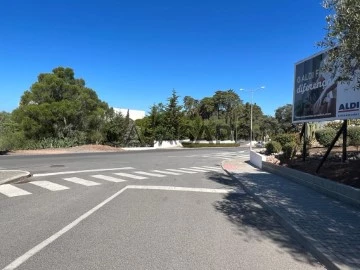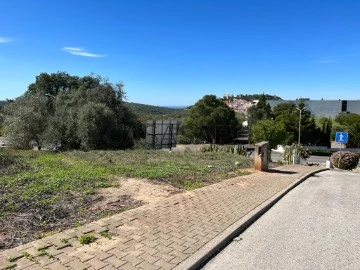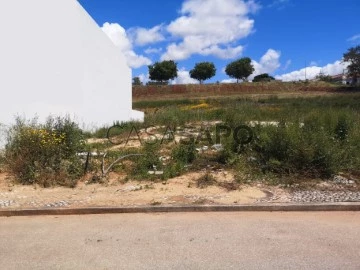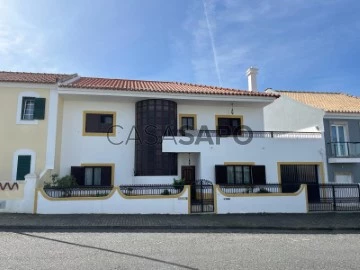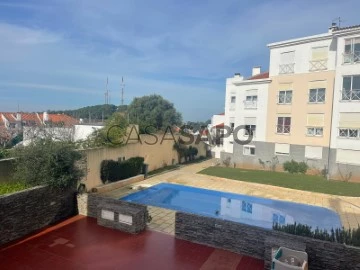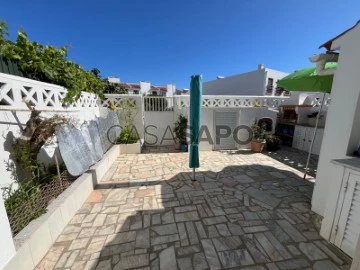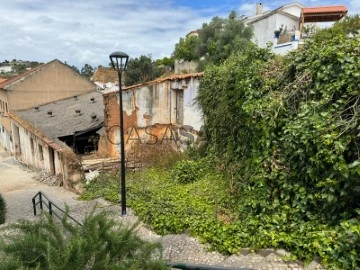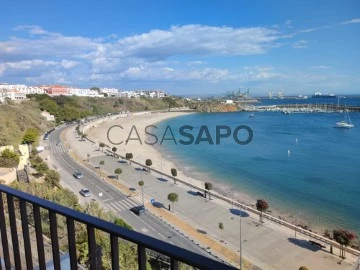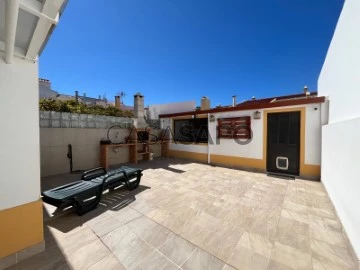
Habita Alentejo
Real Estate License (AMI): 278
M2 - Sociedade de Mediação Imobiliária, Lda
Contact estate agent
Get the advertiser’s contacts
Address
Largo Júdice Fialho, 2 - Loja 02
Real Estate License (AMI): 278
See more
Property Type
Rooms
Price
More filters
11 Properties for near School, Habita Alentejo
Order by
Relevance
Plot
Santiago do Cacém, Santiago do Cacém, S.Cruz e S.Bartolomeu da Serra, Distrito de Setúbal
183m²
buy
70.000 €
Plot for housing - -Santiago do Cacém
Plot of land, for construction of single-family villa, with a total area of 183m2, with an area of implementation of 87m2 and construction area of 242m2.
Based on the allotment permit issued by the CM of Santiago do Cacém, it is authorized the construction of a house of typology T4, with basement, two floors and a floor indented.
Situated in a residential area close to commerce and services, with great sun exposure.
Bank Financing:
Habita is a partner of several financial entities enabling all its customers free simulations of Housing Credit.
Location:
Santiago do Cacém is a Portuguese city in the District of Setúbal, is the headquarters of one of the largest municipalities in Portugal, with an area of 1,059.77 km².
It is home to one of the largest municipalities in Portugal, with 1,059.77 km² of area and 29,749 inhabitants (2015 INE), subdivided into 8 parishes.
The municipality is bordered to the north by the term of Grândola, to the northeast by Ferreira do Alentejo, to the east by Aljustrel, to the south by Ourique and Odemira and to the west by Sines and has coastline in the Atlantic Ocean. It is the only municipality in the entire Alentejo that contains 2 cities within its term (Santiago and Santo André). It also has three villages (Cercal, Alvalade and Ermidas-Sado).
Culture and leisure:
There are many popular and cultural manifestations in the county: the feast of Our Lady of Grace, held on the last Sunday of May, with various religious ceremonies, namely prayer meetings, and the annual fairs, on the fourth Sunday of April and the fourth Sunday of July; Santiagro, ’Agricultural Fair’, in May, of economic and cultural promotion; FATAL - Alentejo Coastal Handicraft and Tourism Fair; the traditional Green Grass festivals, both in July; the Monte Fair in September; the traditional festivals of Aldeia dos Chãos in August and The Day of the Municipality, on July 25.
In handicrafts, we highlight the latoaria works, lace, embroidery, clay and cork work, tapestry and wood.
As a cultural installation, the municipality has the Municipal Museum of Santiago do Cacém, in which the numismatics and archeology sections are to be taken up, the latter representative of human occupation in the region, since the times of the Upper Paleolithic. In the collection of ethnography, highlight the traditional Alentejo cuisine, which joins the recreation of a popular room, which makes counterpoint with another of markedly bourgeois taste and which is part of a remarkable legacy of one of the families of the region - the Counties of Avillez.
In 1895 the first automobile arrived in Portugal, owned by the Count of Avilez, santiago do Cacém;
The title of curiosity, also the 1st Rolls Royce that came to Portugal, came to Santiago do Cacém, owned by José Sande Champalimaud and the car registration with no. 1, in 1904, went also to Santiago do Cacém, on behalf of Augusto Teixeira de Aragão.
Points to visit:
- Castle of Santiago do Cacém
- Miróbriga Archaeological Station
- Municipal Museum of Santiago do Cacém
- Castle of Santiago do Cacém
- Badoca Safari Park
- Medieval Alvalade Bridge
- Old Castle area with the ruins of the Roman city Miróbriga
- Church of Santiago or Mother Church of Santiago do Cacém
Plot of land, for construction of single-family villa, with a total area of 183m2, with an area of implementation of 87m2 and construction area of 242m2.
Based on the allotment permit issued by the CM of Santiago do Cacém, it is authorized the construction of a house of typology T4, with basement, two floors and a floor indented.
Situated in a residential area close to commerce and services, with great sun exposure.
Bank Financing:
Habita is a partner of several financial entities enabling all its customers free simulations of Housing Credit.
Location:
Santiago do Cacém is a Portuguese city in the District of Setúbal, is the headquarters of one of the largest municipalities in Portugal, with an area of 1,059.77 km².
It is home to one of the largest municipalities in Portugal, with 1,059.77 km² of area and 29,749 inhabitants (2015 INE), subdivided into 8 parishes.
The municipality is bordered to the north by the term of Grândola, to the northeast by Ferreira do Alentejo, to the east by Aljustrel, to the south by Ourique and Odemira and to the west by Sines and has coastline in the Atlantic Ocean. It is the only municipality in the entire Alentejo that contains 2 cities within its term (Santiago and Santo André). It also has three villages (Cercal, Alvalade and Ermidas-Sado).
Culture and leisure:
There are many popular and cultural manifestations in the county: the feast of Our Lady of Grace, held on the last Sunday of May, with various religious ceremonies, namely prayer meetings, and the annual fairs, on the fourth Sunday of April and the fourth Sunday of July; Santiagro, ’Agricultural Fair’, in May, of economic and cultural promotion; FATAL - Alentejo Coastal Handicraft and Tourism Fair; the traditional Green Grass festivals, both in July; the Monte Fair in September; the traditional festivals of Aldeia dos Chãos in August and The Day of the Municipality, on July 25.
In handicrafts, we highlight the latoaria works, lace, embroidery, clay and cork work, tapestry and wood.
As a cultural installation, the municipality has the Municipal Museum of Santiago do Cacém, in which the numismatics and archeology sections are to be taken up, the latter representative of human occupation in the region, since the times of the Upper Paleolithic. In the collection of ethnography, highlight the traditional Alentejo cuisine, which joins the recreation of a popular room, which makes counterpoint with another of markedly bourgeois taste and which is part of a remarkable legacy of one of the families of the region - the Counties of Avillez.
In 1895 the first automobile arrived in Portugal, owned by the Count of Avilez, santiago do Cacém;
The title of curiosity, also the 1st Rolls Royce that came to Portugal, came to Santiago do Cacém, owned by José Sande Champalimaud and the car registration with no. 1, in 1904, went also to Santiago do Cacém, on behalf of Augusto Teixeira de Aragão.
Points to visit:
- Castle of Santiago do Cacém
- Miróbriga Archaeological Station
- Municipal Museum of Santiago do Cacém
- Castle of Santiago do Cacém
- Badoca Safari Park
- Medieval Alvalade Bridge
- Old Castle area with the ruins of the Roman city Miróbriga
- Church of Santiago or Mother Church of Santiago do Cacém
Contact
Plot
Santiago do Cacém, Santiago do Cacém, S.Cruz e S.Bartolomeu da Serra, Distrito de Setúbal
386m²
buy
90.000 €
Plot of land, for construction of single-family villa, with a total area of 386m2, with an implementation area of 87m2 and construction area of 242m2.
Based on the allotment permit issued by the CM of Santiago do Cacém, it is authorized the construction of a house of typology T4, with basement, two floors and a floor indented.
Situated in a residential area close to commerce and services, with great sun exposure.
Bank Financing:
Habita is a partner of several financial entities enabling all its customers free simulations of Housing Credit.
Location:
Santiago do Cacém is a Portuguese city in the District of Setúbal, is the headquarters of one of the largest municipalities in Portugal, with an area of 1,059.77 km².
It is home to one of the largest municipalities in Portugal, with 1,059.77 km² of area and 29,749 inhabitants (2015 INE), subdivided into 8 parishes.
The municipality is bordered to the north by the term of Grândola, to the northeast by Ferreira do Alentejo, to the east by Aljustrel, to the south by Ourique and Odemira and to the west by Sines and has coastline in the Atlantic Ocean. It is the only municipality in the entire Alentejo that contains 2 cities within its term (Santiago and Santo André). It also has three villages (Cercal, Alvalade and Ermidas-Sado).
Culture and leisure:
There are many popular and cultural manifestations in the county: the feast of Our Lady of Grace, held on the last Sunday of May, with various religious ceremonies, namely prayer meetings, and the annual fairs, on the fourth Sunday of April and the fourth Sunday of July; Santiagro, ’Agricultural Fair’, in May, of economic and cultural promotion; FATAL - Alentejo Coastal Handicraft and Tourism Fair; the traditional Green Grass festivals, both in July; the Monte Fair in September; the traditional festivals of Aldeia dos Chãos in August and The Day of the Municipality, on July 25.
In handicrafts, we highlight the latoaria works, lace, embroidery, clay and cork work, tapestry and wood.
As a cultural installation, the municipality has the Municipal Museum of Santiago do Cacém, in which the numismatics and archeology sections are to be taken up, the latter representative of human occupation in the region, since the times of the Upper Paleolithic. In the collection of ethnography, highlight the traditional Alentejo cuisine, which joins the recreation of a popular room, which makes counterpoint with another of markedly bourgeois taste and which is part of a remarkable legacy of one of the families of the region - the Counties of Avillez.
In 1895 the first automobile arrived in Portugal, owned by the Count of Avilez, santiago do Cacém;
The title of curiosity, also the 1st Rolls Royce that came to Portugal, came to Santiago do Cacém, owned by José Sande Champalimaud and the car registration with no. 1, in 1904, went also to Santiago do Cacém, on behalf of Augusto Teixeira de Aragão.
Points to visit:
- Castle of Santiago do Cacém
- Miróbriga Archaeological Station
- Municipal Museum of Santiago do Cacém
- Castle of Santiago do Cacém
- Badoca Safari Park
- Medieval Alvalade Bridge
- Old Castle area with the ruins of the Roman city Miróbriga
- Church of Santiago or Mother Church of Santiago do Cacém
Based on the allotment permit issued by the CM of Santiago do Cacém, it is authorized the construction of a house of typology T4, with basement, two floors and a floor indented.
Situated in a residential area close to commerce and services, with great sun exposure.
Bank Financing:
Habita is a partner of several financial entities enabling all its customers free simulations of Housing Credit.
Location:
Santiago do Cacém is a Portuguese city in the District of Setúbal, is the headquarters of one of the largest municipalities in Portugal, with an area of 1,059.77 km².
It is home to one of the largest municipalities in Portugal, with 1,059.77 km² of area and 29,749 inhabitants (2015 INE), subdivided into 8 parishes.
The municipality is bordered to the north by the term of Grândola, to the northeast by Ferreira do Alentejo, to the east by Aljustrel, to the south by Ourique and Odemira and to the west by Sines and has coastline in the Atlantic Ocean. It is the only municipality in the entire Alentejo that contains 2 cities within its term (Santiago and Santo André). It also has three villages (Cercal, Alvalade and Ermidas-Sado).
Culture and leisure:
There are many popular and cultural manifestations in the county: the feast of Our Lady of Grace, held on the last Sunday of May, with various religious ceremonies, namely prayer meetings, and the annual fairs, on the fourth Sunday of April and the fourth Sunday of July; Santiagro, ’Agricultural Fair’, in May, of economic and cultural promotion; FATAL - Alentejo Coastal Handicraft and Tourism Fair; the traditional Green Grass festivals, both in July; the Monte Fair in September; the traditional festivals of Aldeia dos Chãos in August and The Day of the Municipality, on July 25.
In handicrafts, we highlight the latoaria works, lace, embroidery, clay and cork work, tapestry and wood.
As a cultural installation, the municipality has the Municipal Museum of Santiago do Cacém, in which the numismatics and archeology sections are to be taken up, the latter representative of human occupation in the region, since the times of the Upper Paleolithic. In the collection of ethnography, highlight the traditional Alentejo cuisine, which joins the recreation of a popular room, which makes counterpoint with another of markedly bourgeois taste and which is part of a remarkable legacy of one of the families of the region - the Counties of Avillez.
In 1895 the first automobile arrived in Portugal, owned by the Count of Avilez, santiago do Cacém;
The title of curiosity, also the 1st Rolls Royce that came to Portugal, came to Santiago do Cacém, owned by José Sande Champalimaud and the car registration with no. 1, in 1904, went also to Santiago do Cacém, on behalf of Augusto Teixeira de Aragão.
Points to visit:
- Castle of Santiago do Cacém
- Miróbriga Archaeological Station
- Municipal Museum of Santiago do Cacém
- Castle of Santiago do Cacém
- Badoca Safari Park
- Medieval Alvalade Bridge
- Old Castle area with the ruins of the Roman city Miróbriga
- Church of Santiago or Mother Church of Santiago do Cacém
Contact
Shop
Sines, Distrito de Setúbal
Used · 50m²
buy
90.000 €
Loja bastante ampla onde está inserido um Cabeleireiro, com todo o equipamento, duas rampas de lavagem, quatro bancadas para penteados com apoios laterais para produtos e secadores, quatro cadeiras com elevação hidráulica, três mesas ajudantes, um secador de pé, secadores de mão, cinco sofás de espera, quatro móveis de apoio com bastante arrumação, casa de banho e arrumos.
Localizada no centro comercial SineShopping, inserido em zona central de comércio da cidade de Sines.
Financiamento Bancário:
A Habita é parceira de várias entidades financeiras possibilitando a todos os seus clientes simulações gratuitas de Crédito à Habitação.
Localização:
Sines é uma cidade portuguesa do distrito de Setúbal e a sua história tem sido moldada pelo mar
O município é limitado a norte e leste pelo município de Santiago do Cacém, a sul por Odemira e a Oeste o Oceano Atlântico.
Fica a 160 km a sul de Lisboa, na ponta do Cabo de Sines que separa o litoral alentejano em 2 partes: para norte extensas praias de areia fina até Troia e para sul praias de enseada que fazem parte do Parque Natural do Sudoeste Alentejano e Costa Vicentina.
Os fenícios foram os primeiros a explorar a região e os romanos fizeram de Sines um porto perto de Miróbriga (Santiago do Cacém) - a origem da palavra Sines vem do latin Sinus , ’recorte da costa marítima’
O filho mais conhecido de Sines foi o navegador Vasco da Gama, cavaleiro da Ordem de Cristo, que entrou na história ao descobrir a rota marítima para a Índia no fim do século XV.
Da Pré-História aos dias de hoje foram o mar e os seus recursos que definiram a economia, a cultura, a composição e até o caráter das suas gentes, nessa medida, a história de Sines é vasta desde das evidências da existência de populações humanas através de vestígios de alguns desses povoamentos a descoberto em estações arqueológicas como a Palmeirinha e a Quitéria, passando pela Escola Naval Italiana em Sines nos séculos XV/XVI, que dava formação em engenheira naval de construção de embarcações para o serviço do reino e os outros reinos da Europa, até ao acordo entre Portugal e Inglaterra no século XIX para iniciar a produtividade de agricultura, de animais e de cortiça em território no Litoral Alentejano e o desenvolvimento das vilas de Sines, de Santiago do Cacém, de Odemira, de Santo André e de Milfontes e das aldeias de Porto Côvo, de Melides, de Abela e de Grândola.
O século XX começa praticamente com a restauração do município, em 1914. A indústria da cortiça, a pesca e alguma agricultura e turismo constituem a base da vida de Sines até ao final da década de 60, quando, além da proximidade do mar, Sines pouco se distingue do resto do Alentejo.
Já a meio do XX, o grande complexo industrial criado pelo governo de Marcello Caetano em Sines, em 1970, muda o concelho. A população explode e diversifica-se, a paisagem ganha novas configurações e a comunidade luta para manter a sua integridade e a qualidade de vida, mitigando os impactes negativos da instalação das novas unidades e aproveitando os positivos.
Hoje pelo porto de águas profundas de Sines já passa mais de metade do tráfego portuário em Portugal, sobretudo de contentores. E o alargamento do canal do Panamá poderá dar um grande impulso a Sines, desde que seja finalmente construída uma adequada ligação ferroviária a Espanha e Europa Central.
No centro da baía de Sines fica a ampla Praia Vasco da Gama, adormecida entre os pontões. É vigiada no verão, de fácil acesso e seu passeio proporciona caminhadas tranquilas.
Para leste, descortina o simpático Porto de Recreio, o único até à costa algarvia, com 250 lugares para embarcações de lazer, eletricidade, instalações sanitárias, lavandaria, posto de abastecimento de combustíveis e WiFi.
Cultura e Lazer:
Sines tem um património histórico fantástico desde do Castelo de Sines, do Forte do Revelim, do Forte do Pessegueiro, do Padrão de São Torpes, várias igrejas como Nossa Senhora da Soledade, Espírito Santo ou da Misericórdia, Matriz de São Salvador ou da Nossa Senhora das Salas, para além das fabulosas praias que merecem um mergulho, pode-se aproveitar para fazer um jogging no muro da praia.
Junto à praia, ocorre o festival gastronómico Tasquinhas Sines em julho. O peixe e o marisco estão no centro da culinária local, que vem diretamente da lota. Pratos como a açorda de marisco e a feijoada de búzios são típicos exemplos da influência dum Alentejo mais rural.
Os principais eventos em Sines são o Carnaval e o festival Músicas do Mundo.
Educação:
Sines tem várias escolas básicas públicas e infantários além de existirem instituições privadas de referência garantido o acesso a bons estudos para pessoas de diversas classes sociais que torna a cidade uma excelente localização para morar e estudar.
Localizada no centro comercial SineShopping, inserido em zona central de comércio da cidade de Sines.
Financiamento Bancário:
A Habita é parceira de várias entidades financeiras possibilitando a todos os seus clientes simulações gratuitas de Crédito à Habitação.
Localização:
Sines é uma cidade portuguesa do distrito de Setúbal e a sua história tem sido moldada pelo mar
O município é limitado a norte e leste pelo município de Santiago do Cacém, a sul por Odemira e a Oeste o Oceano Atlântico.
Fica a 160 km a sul de Lisboa, na ponta do Cabo de Sines que separa o litoral alentejano em 2 partes: para norte extensas praias de areia fina até Troia e para sul praias de enseada que fazem parte do Parque Natural do Sudoeste Alentejano e Costa Vicentina.
Os fenícios foram os primeiros a explorar a região e os romanos fizeram de Sines um porto perto de Miróbriga (Santiago do Cacém) - a origem da palavra Sines vem do latin Sinus , ’recorte da costa marítima’
O filho mais conhecido de Sines foi o navegador Vasco da Gama, cavaleiro da Ordem de Cristo, que entrou na história ao descobrir a rota marítima para a Índia no fim do século XV.
Da Pré-História aos dias de hoje foram o mar e os seus recursos que definiram a economia, a cultura, a composição e até o caráter das suas gentes, nessa medida, a história de Sines é vasta desde das evidências da existência de populações humanas através de vestígios de alguns desses povoamentos a descoberto em estações arqueológicas como a Palmeirinha e a Quitéria, passando pela Escola Naval Italiana em Sines nos séculos XV/XVI, que dava formação em engenheira naval de construção de embarcações para o serviço do reino e os outros reinos da Europa, até ao acordo entre Portugal e Inglaterra no século XIX para iniciar a produtividade de agricultura, de animais e de cortiça em território no Litoral Alentejano e o desenvolvimento das vilas de Sines, de Santiago do Cacém, de Odemira, de Santo André e de Milfontes e das aldeias de Porto Côvo, de Melides, de Abela e de Grândola.
O século XX começa praticamente com a restauração do município, em 1914. A indústria da cortiça, a pesca e alguma agricultura e turismo constituem a base da vida de Sines até ao final da década de 60, quando, além da proximidade do mar, Sines pouco se distingue do resto do Alentejo.
Já a meio do XX, o grande complexo industrial criado pelo governo de Marcello Caetano em Sines, em 1970, muda o concelho. A população explode e diversifica-se, a paisagem ganha novas configurações e a comunidade luta para manter a sua integridade e a qualidade de vida, mitigando os impactes negativos da instalação das novas unidades e aproveitando os positivos.
Hoje pelo porto de águas profundas de Sines já passa mais de metade do tráfego portuário em Portugal, sobretudo de contentores. E o alargamento do canal do Panamá poderá dar um grande impulso a Sines, desde que seja finalmente construída uma adequada ligação ferroviária a Espanha e Europa Central.
No centro da baía de Sines fica a ampla Praia Vasco da Gama, adormecida entre os pontões. É vigiada no verão, de fácil acesso e seu passeio proporciona caminhadas tranquilas.
Para leste, descortina o simpático Porto de Recreio, o único até à costa algarvia, com 250 lugares para embarcações de lazer, eletricidade, instalações sanitárias, lavandaria, posto de abastecimento de combustíveis e WiFi.
Cultura e Lazer:
Sines tem um património histórico fantástico desde do Castelo de Sines, do Forte do Revelim, do Forte do Pessegueiro, do Padrão de São Torpes, várias igrejas como Nossa Senhora da Soledade, Espírito Santo ou da Misericórdia, Matriz de São Salvador ou da Nossa Senhora das Salas, para além das fabulosas praias que merecem um mergulho, pode-se aproveitar para fazer um jogging no muro da praia.
Junto à praia, ocorre o festival gastronómico Tasquinhas Sines em julho. O peixe e o marisco estão no centro da culinária local, que vem diretamente da lota. Pratos como a açorda de marisco e a feijoada de búzios são típicos exemplos da influência dum Alentejo mais rural.
Os principais eventos em Sines são o Carnaval e o festival Músicas do Mundo.
Educação:
Sines tem várias escolas básicas públicas e infantários além de existirem instituições privadas de referência garantido o acesso a bons estudos para pessoas de diversas classes sociais que torna a cidade uma excelente localização para morar e estudar.
Contact
Residential Plot
Santiago do Cacém, S.Cruz e S.Bartolomeu da Serra, Distrito de Setúbal
Used · 410m²
buy
95.000 €
Plot of land with an area of 410m2 for construction of a dwelling, with implantation area of 130m2 with total construction of 305m2.
Located in a residential area and next to schools.
Bank Financing:
Habita is a partner of several financial entities enabling all its customers free simulations of Housing Credit.
location:
Santiago do Cacém is a Portuguese city in the District of Setúbal, is the headquarters of one of the largest municipalities in Portugal, with an area of 1,059.77 km².
It is home to one of the largest municipalities in Portugal, with 1,059.77 km² of area and 29,749 inhabitants (2015 INE), subdivided into 8 parishes.
The municipality is bordered to the north by the term of Grândola, to the northeast by Ferreira do Alentejo, to the east by Aljustrel, to the south by Ourique and Odemira and to the west by Sines and has coastline in the Atlantic Ocean. It is the only municipality in the entire Alentejo that contains 2 cities within its term (Santiago and Santo André). It also has three villages (Cercal, Alvalade and Ermidas-Sado).
history:
Its name derives from The Mooring Governor Kassim and the Order of Santiago.
Endorsed in a strategic geographical location, human populations have sought this region since remote times to establish itself. The excavations carried out in the Old Castle, where the Roman ruins of Miróbriga are located, show that the region has been inhabited since prehistory.
The ruins of Miróbriga represent one of the most striking traces of the occupation of the Romans in southwestern Portugal.
It was classified as a Property of Public Interest in 1940. The Roman city stretches for more than 2 km, featuring ruins of housing buildings, paved streets, a racetrack, a bathing, a bridge and a forum.
With Roman colonization, it developed into the commercial area around the forum. The termes, among the best preserved in Portugal. Relatively close to the terme, there is a bridge with a single semicircular arch. The hippodrome is the only fully known in Portuga and is located farther from the center.
It was around 712 and already after the decline of Miróbriga that the Moors reached the territory, building the castle on the hill in front; it is even thought that the name Kassem will be linked to the Mooring villager. The Moorish occupation lasted until the 19th century. XII and many battles for the reconquest took place in the territory until, in 1217, he returned definitively to the possession of Christians, and D. Afonso II confirmed the donation of his father to the Order of Skewers.
economy:
In the municipality, activities related to the primary sector predominate, followed by secondary and tertiary activities.
Agriculture still maintains great importance, with 43.9% of the municipality’s area destined for agricultural exploration, especially the cultivation of cereals for grain, temporary grassland and forage crops, industrial crops, pousio, olive groves, grassland and permanent pastures.
Livestock farming is also of some importance, particularly in the breeding of birds, sheep and pigs.
About 7785 hectares of its territory are covered with forest.
Thus, agriculture, swine farming and rice husking are the most important activities, followed by industry, namely self-catering workshops, civil construction, civil locksmithing, marble processing, wood sawing and cork processing.
Culture and leisure:
There are many popular and cultural manifestations in the county: the feast of Our Lady of Grace, held on the last Sunday of May, with various religious ceremonies, namely prayer meetings, and the annual fairs, on the fourth Sunday of April and the fourth Sunday of July; Santiagro, ’Agricultural Fair’, in May, of economic and cultural promotion; FATAL - Alentejo Coastal Handicraft and Tourism Fair; the traditional Green Grass festivals, both in July; the Monte Fair in September; the traditional festivals of Aldeia dos Chãos in August and The Day of the Municipality, on July 25.
In handicrafts, we highlight the latoaria works, lace, embroidery, clay and cork work, tapestry and wood.
As a cultural installation, the municipality has the Municipal Museum of Santiago do Cacém, in which the numismatics and archeology sections are to be taken up, the latter representative of human occupation in the region, since the times of the Upper Paleolithic. In the collection of ethnography, highlight the traditional Alentejo cuisine, which joins the recreation of a popular room, which makes counterpoint with another of markedly bourgeois taste and which is part of a remarkable legacy of one of the families of the region - the Counties of Avillez.
In 1895 the first automobile arrived in Portugal, owned by the Count of Avilez, santiago do Cacém;
The title of curiosity, also the 1st Rolls Royce that came to Portugal, came to Santiago do Cacém, owned by José Sande Champalimaud and the car registration with no. 1, in 1904, went also to Santiago do Cacém, on behalf of Augusto Teixeira de Aragão.
Points to visit:
- Castle of Santiago do Cacém
- Miróbriga Archaeological Station
- Municipal Museum of Santiago do Cacém
- Castle of Santiago do Cacém
- Badoca Safari Park
- Medieval Alvalade Bridge
- Old Castle area with the ruins of the Roman city Miróbriga
- Church of Santiago or Mother Church of Santiago do Cacém
Located in a residential area and next to schools.
Bank Financing:
Habita is a partner of several financial entities enabling all its customers free simulations of Housing Credit.
location:
Santiago do Cacém is a Portuguese city in the District of Setúbal, is the headquarters of one of the largest municipalities in Portugal, with an area of 1,059.77 km².
It is home to one of the largest municipalities in Portugal, with 1,059.77 km² of area and 29,749 inhabitants (2015 INE), subdivided into 8 parishes.
The municipality is bordered to the north by the term of Grândola, to the northeast by Ferreira do Alentejo, to the east by Aljustrel, to the south by Ourique and Odemira and to the west by Sines and has coastline in the Atlantic Ocean. It is the only municipality in the entire Alentejo that contains 2 cities within its term (Santiago and Santo André). It also has three villages (Cercal, Alvalade and Ermidas-Sado).
history:
Its name derives from The Mooring Governor Kassim and the Order of Santiago.
Endorsed in a strategic geographical location, human populations have sought this region since remote times to establish itself. The excavations carried out in the Old Castle, where the Roman ruins of Miróbriga are located, show that the region has been inhabited since prehistory.
The ruins of Miróbriga represent one of the most striking traces of the occupation of the Romans in southwestern Portugal.
It was classified as a Property of Public Interest in 1940. The Roman city stretches for more than 2 km, featuring ruins of housing buildings, paved streets, a racetrack, a bathing, a bridge and a forum.
With Roman colonization, it developed into the commercial area around the forum. The termes, among the best preserved in Portugal. Relatively close to the terme, there is a bridge with a single semicircular arch. The hippodrome is the only fully known in Portuga and is located farther from the center.
It was around 712 and already after the decline of Miróbriga that the Moors reached the territory, building the castle on the hill in front; it is even thought that the name Kassem will be linked to the Mooring villager. The Moorish occupation lasted until the 19th century. XII and many battles for the reconquest took place in the territory until, in 1217, he returned definitively to the possession of Christians, and D. Afonso II confirmed the donation of his father to the Order of Skewers.
economy:
In the municipality, activities related to the primary sector predominate, followed by secondary and tertiary activities.
Agriculture still maintains great importance, with 43.9% of the municipality’s area destined for agricultural exploration, especially the cultivation of cereals for grain, temporary grassland and forage crops, industrial crops, pousio, olive groves, grassland and permanent pastures.
Livestock farming is also of some importance, particularly in the breeding of birds, sheep and pigs.
About 7785 hectares of its territory are covered with forest.
Thus, agriculture, swine farming and rice husking are the most important activities, followed by industry, namely self-catering workshops, civil construction, civil locksmithing, marble processing, wood sawing and cork processing.
Culture and leisure:
There are many popular and cultural manifestations in the county: the feast of Our Lady of Grace, held on the last Sunday of May, with various religious ceremonies, namely prayer meetings, and the annual fairs, on the fourth Sunday of April and the fourth Sunday of July; Santiagro, ’Agricultural Fair’, in May, of economic and cultural promotion; FATAL - Alentejo Coastal Handicraft and Tourism Fair; the traditional Green Grass festivals, both in July; the Monte Fair in September; the traditional festivals of Aldeia dos Chãos in August and The Day of the Municipality, on July 25.
In handicrafts, we highlight the latoaria works, lace, embroidery, clay and cork work, tapestry and wood.
As a cultural installation, the municipality has the Municipal Museum of Santiago do Cacém, in which the numismatics and archeology sections are to be taken up, the latter representative of human occupation in the region, since the times of the Upper Paleolithic. In the collection of ethnography, highlight the traditional Alentejo cuisine, which joins the recreation of a popular room, which makes counterpoint with another of markedly bourgeois taste and which is part of a remarkable legacy of one of the families of the region - the Counties of Avillez.
In 1895 the first automobile arrived in Portugal, owned by the Count of Avilez, santiago do Cacém;
The title of curiosity, also the 1st Rolls Royce that came to Portugal, came to Santiago do Cacém, owned by José Sande Champalimaud and the car registration with no. 1, in 1904, went also to Santiago do Cacém, on behalf of Augusto Teixeira de Aragão.
Points to visit:
- Castle of Santiago do Cacém
- Miróbriga Archaeological Station
- Municipal Museum of Santiago do Cacém
- Castle of Santiago do Cacém
- Badoca Safari Park
- Medieval Alvalade Bridge
- Old Castle area with the ruins of the Roman city Miróbriga
- Church of Santiago or Mother Church of Santiago do Cacém
Contact
House 6 Bedrooms
Santo André, Santiago do Cacém, Distrito de Setúbal
Used · 280m²
With Garage
buy
480.000 €
Moradia em Vila Nova de Santo André com 280m2 projetada para proporcionar conforto e elegância.
Composta por r/c com hall de entrada , cozinha, despensa, uma sala ampla, casa de banho, dois quartos e um excelente e generoso logradouro. No primeiro andar disponibiliza 4 quartos bastante espaçosos e 1 casas de banho.
Todos os compartimentos da casa oferecem amplitude e muita luz natural.
A cave é muito versátil, adequando-se a diversos usos, enquanto as varandas proporcionam momentos relaxantes.
A 10 minutos de Sines e das praias de São Torpes, tem vista para o pinhal e localiza-se num bairro muito tranquilo.
Escolas e serviços muito próximas do bairro.
Não perca a oportunidade de conhecer este imóvel.
Financiamento Bancário:
A Habita é parceira de várias entidades financeiras possibilitando a todos os seus clientes simulações gratuitas de Crédito à Habitação.
Localização:
A Costa de Santo André fica a 10 minutos de Vila Nova de Santo André, a 15m da Praia de Melides e a 15 km de Santiago do Cacém, surge a imensa praia da Lagoa de Santo André.
A ampla lagoa, com um par de metros de profundidade, é apoiada por uma extensa reserva natural de pinheiros pelo que o desenvolvimento urbano é, portanto, condicionado
Situada no Alentejo, a Reserva Natural das Lagoas de Santo André e da Sancha ocupa parte do litoral dos municípios de Sines e de Santiago do Cacém e um sector marinho com 1,5 km de largura definido a partir da linha de costa.
Em plena costa alentejana, a Reserva Natural das Lagoas de Santo André e da Sancha estende-se ao longo de 16 km e integra duas lagoas: a Lagoa de Santo André, a maior do litoral alentejano, e a Lagoa da Sancha, de dimensões mais reduzidas.
A Lagoa de Santo André, é a maior lagoa do litoral alentejano com cerca de 500 hectares. Já a Lagoa da Sancha tem de dimensões mais reduzidas, cerca de 15 hectares. O seu estatuto de proteção reconhece o elevado valor ecológico destas duas zonas húmidas e das suas áreas envolventes, que incluem também o cordão dunar que as separa do oceano, bem como a faixa marítima adjacente.
Estas condições naturais atraem muitas aves, que aqui permanecem em alturas em que outras zonas já estão total ou parcialmente secas, fazendo com que o final do verão/início do outono seja a época mais aconselhada para a sua observação.
De grande beleza natural, a paisagem que envolve as lagoas é maioritariamente constituída por caniçais, juncais, salgueirais, matos atlânticos, pinhais, dunas e extensas praias de areia branca.
Deve visitar o Centro de Interpretação do Monte do Paio, destinado a promover o conhecimento da Reserva Natural, proporcionando uma das melhores vistas panorâmicas sobre a Lagoa de Santo André.
Anualmente pode-se assistir à abertura da Lagoa de Santo André ao mar. Um evento único de experienciar, que decorre no início da primavera para renovar as águas da lagoa, limpar os seus fundos e permitir a entrada de várias espécies de peixes.
O Festival da Enguia da Lagoa Santo André decorre normalmente em fevereiro, esperando milhares de visitantes para degustar os mais variados pratos confecionados com uma iguaria única, a enguia.
As Festas de São Romão decorrem em Agosto e tem um programa que pretende recriar ’o único dia do ano em que as populações iam à praia’, numa autêntica romaria, com um cortejo que ligava as várias aldeias do interior do concelho à Costa de Santo André, no litoral alentejano. As festas têm o seu ponto alto com a recriação do Banho de São Romão onde há o banho de mar com os trajes típicos da época e animação na praia .
Licença de Utilização nº319/95 Câmara Municipal Santiago do Cacém
Composta por r/c com hall de entrada , cozinha, despensa, uma sala ampla, casa de banho, dois quartos e um excelente e generoso logradouro. No primeiro andar disponibiliza 4 quartos bastante espaçosos e 1 casas de banho.
Todos os compartimentos da casa oferecem amplitude e muita luz natural.
A cave é muito versátil, adequando-se a diversos usos, enquanto as varandas proporcionam momentos relaxantes.
A 10 minutos de Sines e das praias de São Torpes, tem vista para o pinhal e localiza-se num bairro muito tranquilo.
Escolas e serviços muito próximas do bairro.
Não perca a oportunidade de conhecer este imóvel.
Financiamento Bancário:
A Habita é parceira de várias entidades financeiras possibilitando a todos os seus clientes simulações gratuitas de Crédito à Habitação.
Localização:
A Costa de Santo André fica a 10 minutos de Vila Nova de Santo André, a 15m da Praia de Melides e a 15 km de Santiago do Cacém, surge a imensa praia da Lagoa de Santo André.
A ampla lagoa, com um par de metros de profundidade, é apoiada por uma extensa reserva natural de pinheiros pelo que o desenvolvimento urbano é, portanto, condicionado
Situada no Alentejo, a Reserva Natural das Lagoas de Santo André e da Sancha ocupa parte do litoral dos municípios de Sines e de Santiago do Cacém e um sector marinho com 1,5 km de largura definido a partir da linha de costa.
Em plena costa alentejana, a Reserva Natural das Lagoas de Santo André e da Sancha estende-se ao longo de 16 km e integra duas lagoas: a Lagoa de Santo André, a maior do litoral alentejano, e a Lagoa da Sancha, de dimensões mais reduzidas.
A Lagoa de Santo André, é a maior lagoa do litoral alentejano com cerca de 500 hectares. Já a Lagoa da Sancha tem de dimensões mais reduzidas, cerca de 15 hectares. O seu estatuto de proteção reconhece o elevado valor ecológico destas duas zonas húmidas e das suas áreas envolventes, que incluem também o cordão dunar que as separa do oceano, bem como a faixa marítima adjacente.
Estas condições naturais atraem muitas aves, que aqui permanecem em alturas em que outras zonas já estão total ou parcialmente secas, fazendo com que o final do verão/início do outono seja a época mais aconselhada para a sua observação.
De grande beleza natural, a paisagem que envolve as lagoas é maioritariamente constituída por caniçais, juncais, salgueirais, matos atlânticos, pinhais, dunas e extensas praias de areia branca.
Deve visitar o Centro de Interpretação do Monte do Paio, destinado a promover o conhecimento da Reserva Natural, proporcionando uma das melhores vistas panorâmicas sobre a Lagoa de Santo André.
Anualmente pode-se assistir à abertura da Lagoa de Santo André ao mar. Um evento único de experienciar, que decorre no início da primavera para renovar as águas da lagoa, limpar os seus fundos e permitir a entrada de várias espécies de peixes.
O Festival da Enguia da Lagoa Santo André decorre normalmente em fevereiro, esperando milhares de visitantes para degustar os mais variados pratos confecionados com uma iguaria única, a enguia.
As Festas de São Romão decorrem em Agosto e tem um programa que pretende recriar ’o único dia do ano em que as populações iam à praia’, numa autêntica romaria, com um cortejo que ligava as várias aldeias do interior do concelho à Costa de Santo André, no litoral alentejano. As festas têm o seu ponto alto com a recriação do Banho de São Romão onde há o banho de mar com os trajes típicos da época e animação na praia .
Licença de Utilização nº319/95 Câmara Municipal Santiago do Cacém
Contact
Apartment 3 Bedrooms
Santiago do Cacém, S.Cruz e S.Bartolomeu da Serra, Distrito de Setúbal
Remodelled · 110m²
With Garage
buy
330.000 €
Charming 3 bedroom flat in the centre of Santiago do Cacém.
Spacious living room, three bedrooms with fitted wardrobes, 2 bathrooms and a modern, fully equipped kitchen.
Large balconies that provide excellent natural lighting, fireplace with fireplace, garage and storage room.
Gated community, with garden and swimming pool.
Located in a central area, the flat offers easy access to shops and services.
Santiago do Cacém is a Portuguese city in the District of Setúbal, it is the seat of one of the largest municipalities in Portugal, with an area of 1,059.77 km².
Endowed with a strategic geographical location, human populations have sought this region since ancient times to settle. The excavations carried out in the Old Castle, where the Roman ruins of Miróbriga are located, show that the region has been inhabited since prehistoric times.
Spacious living room, three bedrooms with fitted wardrobes, 2 bathrooms and a modern, fully equipped kitchen.
Large balconies that provide excellent natural lighting, fireplace with fireplace, garage and storage room.
Gated community, with garden and swimming pool.
Located in a central area, the flat offers easy access to shops and services.
Santiago do Cacém is a Portuguese city in the District of Setúbal, it is the seat of one of the largest municipalities in Portugal, with an area of 1,059.77 km².
Endowed with a strategic geographical location, human populations have sought this region since ancient times to settle. The excavations carried out in the Old Castle, where the Roman ruins of Miróbriga are located, show that the region has been inhabited since prehistoric times.
Contact
House 3 Bedrooms Triplex
Porto Covo, Sines, Distrito de Setúbal
Used · 120m²
buy
610.000 €
Descubra o encanto de viver em Porto Covo com esta moradia localizada no centro de da Vila, apenas a 5 minutos da praia.
Composta por três pisos, no r/c com quintal, cozinha, sala com lareira e casa de banho, no primeiro andar com três quartos e casa de banho, conta ainda com sótão para arrumação.
A localização privilegiada permite acesso fácil a todas as comodidades locais, restaurantes, lojas, mercado, enquanto a proximidade ao mar oferece a oportunidade de aproveitar dias relaxantes à beira mar.
Não perca a chance de viver num dos destinos mais desejados da Costa Alentejana.
Composta por três pisos, no r/c com quintal, cozinha, sala com lareira e casa de banho, no primeiro andar com três quartos e casa de banho, conta ainda com sótão para arrumação.
A localização privilegiada permite acesso fácil a todas as comodidades locais, restaurantes, lojas, mercado, enquanto a proximidade ao mar oferece a oportunidade de aproveitar dias relaxantes à beira mar.
Não perca a chance de viver num dos destinos mais desejados da Costa Alentejana.
Contact
Ruins
São Salvador e Santa Maria, Odemira, Distrito de Beja
To demolish or rebuild · 254m²
buy
114.000 €
Imóvel Urbano situado no centro de Odemira , esta propriedade oferece um grande potencial de reabilitação .O lote generoso com 254, 50 m2 quadrados com possibilidade de ampliação .
A sua localização central oferece conveniência incomparável de fácil acesso a serviços , lojas e restaurantes assim como ao Rio Mira .
Financiamento Bancário:
A Habita é parceira de várias entidades financeiras possibilitando a todos os seus clientes simulações gratuitas de Crédito à Habitação.
Localização :
Odemira, localizada no sudoeste de Portugal , é uma encantadora vila marcada por sua atmosfera tranquila e cénica. Rodeada por paisagens deslumbrantes, incluindo o rio Mira, suas ruas de paralelepípedos e arquitetura tradicional portuguesa criam uma atmosfera autentica. A rica herança cultural da região se reflete em igrejas históricas, como a igreja da Misericórdia, enquanto os campos agrícolas e colinas circundantes oferecem um cenário pitoresco.
Odemira é conhecida por sua hospitalidade , culinária tradicional e proximidade com praias de beleza singular , tornando-a um destino especial para aqueles que buscam a serenidade e a autenticidade do Alentejo.
A sua localização central oferece conveniência incomparável de fácil acesso a serviços , lojas e restaurantes assim como ao Rio Mira .
Financiamento Bancário:
A Habita é parceira de várias entidades financeiras possibilitando a todos os seus clientes simulações gratuitas de Crédito à Habitação.
Localização :
Odemira, localizada no sudoeste de Portugal , é uma encantadora vila marcada por sua atmosfera tranquila e cénica. Rodeada por paisagens deslumbrantes, incluindo o rio Mira, suas ruas de paralelepípedos e arquitetura tradicional portuguesa criam uma atmosfera autentica. A rica herança cultural da região se reflete em igrejas históricas, como a igreja da Misericórdia, enquanto os campos agrícolas e colinas circundantes oferecem um cenário pitoresco.
Odemira é conhecida por sua hospitalidade , culinária tradicional e proximidade com praias de beleza singular , tornando-a um destino especial para aqueles que buscam a serenidade e a autenticidade do Alentejo.
Contact
Split Level House 2 Bedrooms Triplex
Sines, Distrito de Setúbal
Used · 119m²
With Garage
buy
700.000 €
****IMÓVEL COM INVESTIMENTO ATIVO****
Imóvel de rendimento, com inquilino.
Excelente refúgio para venda à beira mar em Sines.
Esta deslumbrante moradia com três pisos oferece uma vista única sobre a baía de Sines, com os seus 119m2 de espaço bem aproveitado, no piso 0 uma cozinha toda equipada e varanda, no primeiro piso com sala, quarto, casa de banho e varanda, no segundo piso temos uma suíte e varanda.
Imagine acordar todas as manhãs com a brisa do oceano e o som suave das ondas .
Com uma excelente localização, no centro histórico de Sines, perto de todo o tipo de comércio, a 2 minutos a pé para a praia.
Localização:
Sines é uma cidade portuguesa do distrito de Setúbal e a sua história tem sido moldada pelo mar
O município é limitado a norte e leste pelo município de Santiago do Cacém, a sul por Odemira e a Oeste o Oceano Atlântico.
Fica a 160 km a sul de Lisboa, na ponta do Cabo de Sines que separa o litoral alentejano em 2 partes: para norte extensas praias de areia fina até Troia e para sul praias de enseada que fazem parte do Parque Natural do Sudoeste Alentejano e Costa Vicentina.
Os fenícios foram os primeiros a explorar a região e os romanos fizeram de Sines um porto perto de Miróbriga (Santiago do Cacém) - a origem da palavra Sines vem do latin Sinus , ’recorte da costa marítima’
O filho mais conhecido de Sines foi o navegador Vasco da Gama, cavaleiro da Ordem de Cristo, que entrou na história ao descobrir a rota marítima para a Índia no fim do século XV.
Da Pré-História aos dias de hoje foram o mar e os seus recursos que definiram a economia, a cultura, a composição e até o caráter das suas gentes, nessa medida, a história de Sines é vasta desde das evidências da existência de populações humanas através de vestígios de alguns desses povoamentos a descoberto em estações arqueológicas como a Palmeirinha e a Quitéria, passando pela Escola Naval Italiana em Sines nos séculos XV/XVI, que dava formação em engenheira naval de construção de embarcações para o serviço do reino e os outros reinos da Europa, até ao acordo entre Portugal e Inglaterra no século XIX para iniciar a produtividade de agricultura, de animais e de cortiça em território no Litoral Alentejano e o desenvolvimento das vilas de Sines, de Santiago do Cacém, de Odemira, de Santo André e de Milfontes e das aldeias de Porto Côvo, de Melides, de Abela e de Grândola.
O século XX começa praticamente com a restauração do município, em 1914. A indústria da cortiça, a pesca e alguma agricultura e turismo constituem a base da vida de Sines até ao final da década de 60, quando, além da proximidade do mar, Sines pouco se distingue do resto do Alentejo.
Já a meio do XX, o grande complexo industrial criado pelo governo de Marcello Caetano em Sines, em 1970, muda o concelho. A população explode e diversifica-se, a paisagem ganha novas configurações e a comunidade luta para manter a sua integridade e a qualidade de vida, mitigando os impactes negativos da instalação das novas unidades e aproveitando os positivos.
Hoje pelo porto de águas profundas de Sines já passa mais de metade do tráfego portuário em Portugal, sobretudo de contentores. E o alargamento do canal do Panamá poderá dar um grande impulso a Sines, desde que seja finalmente construída uma adequada ligação ferroviária a Espanha e Europa Central.
No centro da baía de Sines fica a ampla Praia Vasco da Gama, adormecida entre os pontões. É vigiada no verão, de fácil acesso e seu passeio proporciona caminhadas tranquilas.
Para leste, descortina o simpático Porto de Recreio, o único até à costa algarvia, com 250 lugares para embarcações de lazer, eletricidade, instalações sanitárias, lavandaria, posto de abastecimento de combustíveis e WiFi.
Imóvel de rendimento, com inquilino.
Excelente refúgio para venda à beira mar em Sines.
Esta deslumbrante moradia com três pisos oferece uma vista única sobre a baía de Sines, com os seus 119m2 de espaço bem aproveitado, no piso 0 uma cozinha toda equipada e varanda, no primeiro piso com sala, quarto, casa de banho e varanda, no segundo piso temos uma suíte e varanda.
Imagine acordar todas as manhãs com a brisa do oceano e o som suave das ondas .
Com uma excelente localização, no centro histórico de Sines, perto de todo o tipo de comércio, a 2 minutos a pé para a praia.
Localização:
Sines é uma cidade portuguesa do distrito de Setúbal e a sua história tem sido moldada pelo mar
O município é limitado a norte e leste pelo município de Santiago do Cacém, a sul por Odemira e a Oeste o Oceano Atlântico.
Fica a 160 km a sul de Lisboa, na ponta do Cabo de Sines que separa o litoral alentejano em 2 partes: para norte extensas praias de areia fina até Troia e para sul praias de enseada que fazem parte do Parque Natural do Sudoeste Alentejano e Costa Vicentina.
Os fenícios foram os primeiros a explorar a região e os romanos fizeram de Sines um porto perto de Miróbriga (Santiago do Cacém) - a origem da palavra Sines vem do latin Sinus , ’recorte da costa marítima’
O filho mais conhecido de Sines foi o navegador Vasco da Gama, cavaleiro da Ordem de Cristo, que entrou na história ao descobrir a rota marítima para a Índia no fim do século XV.
Da Pré-História aos dias de hoje foram o mar e os seus recursos que definiram a economia, a cultura, a composição e até o caráter das suas gentes, nessa medida, a história de Sines é vasta desde das evidências da existência de populações humanas através de vestígios de alguns desses povoamentos a descoberto em estações arqueológicas como a Palmeirinha e a Quitéria, passando pela Escola Naval Italiana em Sines nos séculos XV/XVI, que dava formação em engenheira naval de construção de embarcações para o serviço do reino e os outros reinos da Europa, até ao acordo entre Portugal e Inglaterra no século XIX para iniciar a produtividade de agricultura, de animais e de cortiça em território no Litoral Alentejano e o desenvolvimento das vilas de Sines, de Santiago do Cacém, de Odemira, de Santo André e de Milfontes e das aldeias de Porto Côvo, de Melides, de Abela e de Grândola.
O século XX começa praticamente com a restauração do município, em 1914. A indústria da cortiça, a pesca e alguma agricultura e turismo constituem a base da vida de Sines até ao final da década de 60, quando, além da proximidade do mar, Sines pouco se distingue do resto do Alentejo.
Já a meio do XX, o grande complexo industrial criado pelo governo de Marcello Caetano em Sines, em 1970, muda o concelho. A população explode e diversifica-se, a paisagem ganha novas configurações e a comunidade luta para manter a sua integridade e a qualidade de vida, mitigando os impactes negativos da instalação das novas unidades e aproveitando os positivos.
Hoje pelo porto de águas profundas de Sines já passa mais de metade do tráfego portuário em Portugal, sobretudo de contentores. E o alargamento do canal do Panamá poderá dar um grande impulso a Sines, desde que seja finalmente construída uma adequada ligação ferroviária a Espanha e Europa Central.
No centro da baía de Sines fica a ampla Praia Vasco da Gama, adormecida entre os pontões. É vigiada no verão, de fácil acesso e seu passeio proporciona caminhadas tranquilas.
Para leste, descortina o simpático Porto de Recreio, o único até à costa algarvia, com 250 lugares para embarcações de lazer, eletricidade, instalações sanitárias, lavandaria, posto de abastecimento de combustíveis e WiFi.
Contact
House 5 Bedrooms Duplex
Sines, Distrito de Setúbal
Used · 78m²
rent
3.000 €
DISPONÍVEL A PARTIR DO DIA 01 DE OUTUBRO
Excelente moradia com cinco quartos para arrendamento em Sines.
A moradia é composta por r/c com sala e cozinha, dois quartos, casa de banho, quintal com excelente exposição solar e anexo, no primeiro andar com três quartos e uma casa de banho.
Preparada para receber cinco pessoas em quartos individuais.
Com uma excelente localização, numa zona residencial bastante calma junto ao LIDL de Sines.
Licença de Utilização 22/2003 - Câmara Municipal de Sines
Excelente moradia com cinco quartos para arrendamento em Sines.
A moradia é composta por r/c com sala e cozinha, dois quartos, casa de banho, quintal com excelente exposição solar e anexo, no primeiro andar com três quartos e uma casa de banho.
Preparada para receber cinco pessoas em quartos individuais.
Com uma excelente localização, numa zona residencial bastante calma junto ao LIDL de Sines.
Licença de Utilização 22/2003 - Câmara Municipal de Sines
Contact
Apartment 1 Bedroom
Areosa, Paranhos, Porto, Distrito do Porto
Under construction · 58m²
With Garage
buy
215.000 €
Apartment T1 NOVO Porto with garage and storage - next to the University Pole - Paranhos.
Inserted in the Vila Ema Building, with gated community with private garden, playground, barbecue and terrace, consisting of only 16 apartments T1 and T2.
Located near Avenida Fernão de Magalhães, having in its surroundings, diverse and just offer of services, such as gyms, grocery stores, Schools, University Pole, São João Hospital Center, public transport, STCP and Metro, as well as the main points of entry / exit of Porto.
Excellent sun exposure, unimpeded views, which combined with glazed windows, provide ample and bright spaces.
Main features:
- Floor area 54m2, with terrace 38m2 and storage with 3m2
- Living room with Kitchen in Open Space, fully equipped with Bosch Appliances
- Parking space
- Solar panels for bleach water
- Pre installation air conditioning
- Pre-installation for charging electric vehicles
Facilities:
- Playground
-Barbecue
- Green spaces
- Common terrace
- Installation of photovoltaic panels for energy production for use of common areas
Bank Financing:
Habita is a partner of several financial entities, enabling all its customers free simulations of Home Loans.
Location:
Paranhos is a Portuguese parish in the municipality of Porto with an area of 6.67 km²[1] and 45,883 inhabitants (2021 census)[2]. The population density is 6,879 inhabitants per km².
The Parish of Paranhos is one of the urban parishes of the city of Porto that, even today, preserves greater popular traditions.
The uses and customs of Paranhos are the picture, on the one hand, of its physical characteristics of the past, of its fertile soils that provided its rural nature and, on the other hand, of its location that traced, for centuries, the paths of the people of the North who visited the then neighboring city of Porto. The current streets of Costa Cabral and Amial represented in the past, the main access roads to Guimarães and Braga, respectively.
Until 1945 those who intended to enter the city were obliged to pay the indirect municipal tax, serving the road of the Circunvalação of border landmark for this purpose.
The urban transformation of the parish that took place mainly in the second half of the twentieth century, erased, in fact, almost all the physical traces that characterized its rurality. However, more difficult to erase are the usages and customs of a population proud to be born, live and take root in Paranhos.
The customs and traditions of this parish are based mainly on characteristics that evoke its rural and peasant origin.
The parish of Paranhos has as its most valuable heritage the largest pole of Higher Education in the city of Porto, the University Pole of Asprela, where numerous colleges, schools, libraries and institutes, state and private, are located.
#ref:PM082302-LD
Inserted in the Vila Ema Building, with gated community with private garden, playground, barbecue and terrace, consisting of only 16 apartments T1 and T2.
Located near Avenida Fernão de Magalhães, having in its surroundings, diverse and just offer of services, such as gyms, grocery stores, Schools, University Pole, São João Hospital Center, public transport, STCP and Metro, as well as the main points of entry / exit of Porto.
Excellent sun exposure, unimpeded views, which combined with glazed windows, provide ample and bright spaces.
Main features:
- Floor area 54m2, with terrace 38m2 and storage with 3m2
- Living room with Kitchen in Open Space, fully equipped with Bosch Appliances
- Parking space
- Solar panels for bleach water
- Pre installation air conditioning
- Pre-installation for charging electric vehicles
Facilities:
- Playground
-Barbecue
- Green spaces
- Common terrace
- Installation of photovoltaic panels for energy production for use of common areas
Bank Financing:
Habita is a partner of several financial entities, enabling all its customers free simulations of Home Loans.
Location:
Paranhos is a Portuguese parish in the municipality of Porto with an area of 6.67 km²[1] and 45,883 inhabitants (2021 census)[2]. The population density is 6,879 inhabitants per km².
The Parish of Paranhos is one of the urban parishes of the city of Porto that, even today, preserves greater popular traditions.
The uses and customs of Paranhos are the picture, on the one hand, of its physical characteristics of the past, of its fertile soils that provided its rural nature and, on the other hand, of its location that traced, for centuries, the paths of the people of the North who visited the then neighboring city of Porto. The current streets of Costa Cabral and Amial represented in the past, the main access roads to Guimarães and Braga, respectively.
Until 1945 those who intended to enter the city were obliged to pay the indirect municipal tax, serving the road of the Circunvalação of border landmark for this purpose.
The urban transformation of the parish that took place mainly in the second half of the twentieth century, erased, in fact, almost all the physical traces that characterized its rurality. However, more difficult to erase are the usages and customs of a population proud to be born, live and take root in Paranhos.
The customs and traditions of this parish are based mainly on characteristics that evoke its rural and peasant origin.
The parish of Paranhos has as its most valuable heritage the largest pole of Higher Education in the city of Porto, the University Pole of Asprela, where numerous colleges, schools, libraries and institutes, state and private, are located.
#ref:PM082302-LD
Contact
Can’t find the property you’re looking for?
